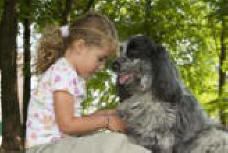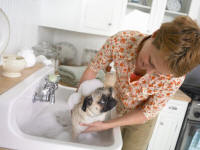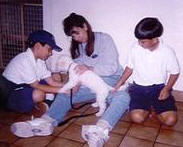Introduction to Nair Trims
 Trimming nails is usually not at the top of Fido's list of favorite
things to do. It's usually not on the owner's top ten of favorite
activities, either! But, nail trims are a necessary part
of maintaining a dog's health and appearance. By following some
specific steps, nail trimming can be turned into a positive
experience. It may never be considered as part of a "hit parade"
but at least the experience can be one that is not dreaded by
dog and human.
Trimming nails is usually not at the top of Fido's list of favorite
things to do. It's usually not on the owner's top ten of favorite
activities, either! But, nail trims are a necessary part
of maintaining a dog's health and appearance. By following some
specific steps, nail trimming can be turned into a positive
experience. It may never be considered as part of a "hit parade"
but at least the experience can be one that is not dreaded by
dog and human.
|
Some dogs will let you do
anything with one hand if
the other is offering a food
treat. Always
introduce new exercises when
the dog is hungry to make
the treats more distracting
and desirable.
|
 Begin with the end in mind...
Begin with the end in mind...
Before the nail
trimmer ever makes its first appearance, the first step is to
desensitize the dog to all handling of his or her feet and nails.
Start by giving your dog a very gentle foot massage while the dog is
sleepy or simply relaxed. Some dogs will let you do anything with
one hand if the other is offering a food treat.

Once the dog is
totally relaxed with you wriggling his or her nails and tapping the
toes, bring out a nail file. Do just a little filing on a few toes,
linking it to happy talk and food treats.
Always introduce new
exercises when the dog is hungry to make the treats more distracting
and desirable.
File or use clippers to remove
the sharp tip only
The
ideal first introduction to a nail clipper is to trim off only the
most extreme sharpest "hooked tip" of the nail.
This is approximately 1/8th of
an inch for a brand new puppy,
or just the tip in older dogs.
After this, use a nail file or
emery board to file the nails.
Start with only 1 or 2 nails at
first, each one accompanied by a
food treat, praise, and lots of
attention. If the dog panics or
has a hard time, then release
the foot. Later on, make an
effort to handle the dog's feet
and the nails during feeding
time (i.e., associate touching
the feet with a positive
experience).
Dogs normally have five toes on
each of the front paws and four
on the back. Some animals are
polydactyl (having more than the
normal number of digits). The
toes that are located on the
inside of the front paws
(similar to where a thumb is
located on humans) are called
dewclaws. Some dogs have
dewclaws on the back paws, but
this is not the norm.
As the dog becomes accustomed to
having his or her feet handled
and the trimming the tip of the
toenails, you can start trimming
off more of the nail. Make sure
that all of the nails are
attended to, including the
dewclaws. Without regular
trimming, nails can grow into
the paw pad and get caught on
objects. Be careful not to
cut into the quick of the nail
(the pink, living tissue inside
the nail closet to the paw). If
you are in doubt about were this
is located, consult with your
veterinarian.
Many dogs have endured negative
experiences with nail trims and
associate nail trims with pain
and fear. The goal in using
sedation is to give the dog the
same compassion as you want when
you go to the dentist, "Please
numb me first!"
If needed, find a veterinary
practice that offers sedation
with nail trims to spare your
dog from physical and
psychological pain.
During a spay, neuter, dentistry or other anesthetic
procedure is a good time to add a nail trim.